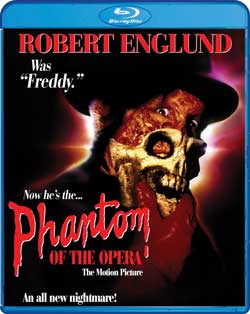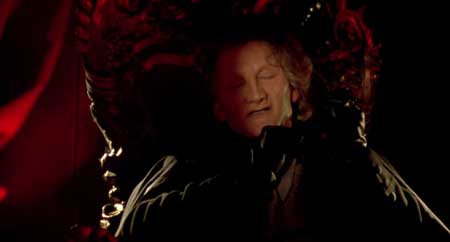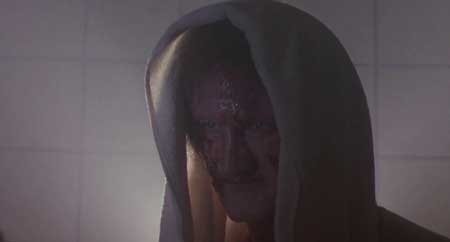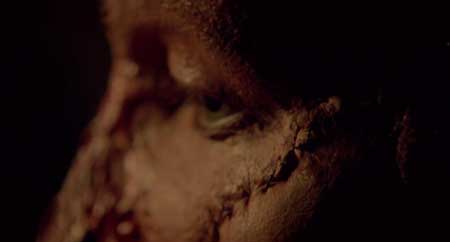SYNOPSIS:
A darker version of the classic Gaston Leroux novel. A young soprano becomes the obsession of a horribly disfigured composer who has plans for those oppose himself or the young singer.
REVIEW:
There are certain stories that people enjoy so much that they are retold many, many times in different forms. They may be told in the form of the written word, or the spoken word. They could be performed in movies, television, or on stage. Something about the story captivates the people who experience it and they want to share it with others. That and the monetary gain from name recognition help to fuel the fire of remakes, reboots, and franchises that have become a major part of the movie industry.
One of the tales that has been told time and time again is that of The Phantom of the Opera. In terms of film, the story was first adapted in 1916. Since then, there have been over 25 adaptations including the 1925 Lon Chaney Sr. version, the 1943 Claude Rains version, the 1962 Hammer Horror version, the 2004 version starring Gerard Butler, and the 1989 horror adaptation that I am going to be writing about. I had never seen any of these movies before watching the Dwight H. Little horror flick from 1989, so I went into it blind. I knew tidbits of the story but not all of it.
The Phantom of the Opera tells the story of an opera actress named Christine Day (Jill Schoelen). She lives in present day New York City. While looking through a library, she discovers a piece of sheet music from 100 years before. Erik Destler (Robert Englund) was the composer. When Jill gets hit in the head with a sandbag during an opera audition, the movie flashes back to the 1880s, where a series of murders occurs surrounding an opera. The culprit is a mysterious phantom. This phantom is in actuality Erik Destler, whose talent came at a price. He asked the devil to be a well-known composer and paid the price of receiving hideous looks. Erik falls for the lead in the opera, who happens to be Christine. The mixture of love and murder does not blend well and leads to a tragic end.
The movie in itself is well made. Dwight H. Little might not be a director on par with greats such as David Fincher, Alfred Hitchcock, or Steven Spielberg. But he does have a history of making solid movies. He is a capable enough director that has brought me some fairly good entertainment time and time again. The Phantom of the Opera is no exception to this. It takes a classic story and adds some 1980s gore in order to bring it to the horror audiences. For the most part, the gore works. This is particularly true of the effects used for Erik’s face. Due to the nature of his punishment for being famous, Erik diligently works on bringing back his looks. He does so with pieces of other people’s flesh. There are multiple scenes in which flesh is added to or removed from his face. Each time looks eerily realistic to the point where squeamish people would likely need to look away from the screen. The effects help bring out the strengths in this rendition of The Phantom of the Opera.
My main issue with the movie is what it could have been. The New York bookends to the movie are much more promising than the gory update of the period set love story that The Phantom of the Opera ended up being. I would have rather seen the modern day version of the story that the end of the movie highlighted for a few moments. The classic period set tale has been told countless times. Adding the gore was nice and all, but an updated version of the story set in a contemporary time could have been more daring and made for a more interesting movie. Not that this wasn’t interesting. It just could have been more.
Other than that stuff, the movie was a solid horror movie. It had Robert Englund playing the good kind of bad guy that makes him the man he his. The other acting was solid too. Nothing really stood out though. The story was… It was The Phantom of the Opera. A man falls in love with a woman and does crazy things because of it. That’s mildly entertaining. The set design and costumes all worked to the movie’s benefit making the past feel like the past and the present feel like the present. There’s not too much to take away from any of the rest of the movie.
As an introduction to The Phantom of the Opera, I think this was one of the best ways I could have possibly been brought in. It was from a director that usually makes solid movies, it brought some gory horror into the mix, and it told the story in what I believe was a mostly accurate way. It might not be for everyone. It’s easily understandable that some people might not be into the period setting that most of the movie takes place in. But the movie is good enough to be watched by anyone looking for a solid horror version of a classic tale. And it’s worth it to see Robert England playing The Phantom. What’s not to like about that?
Bonus Features
- Audio Commentary With Director Dwight H. Little And Actor Robert Englund
- Behind The Mask: The Making Of “The Phantom Of The Opera,” Featuring New Interviews With Director Dwight H. Little, Actors Robert Englund, Jill Schoelen, And Alex Hyde-White, Screenwriter Duke Sandefur, Special Make-Up Designer Kevin Yagher, And More!
- Theatrical Trailer
- TV Spot
- Radio Spots
- Still Gallery
The Phantom of the Opera is now available on bluray per Shout Factory
 Horror News | HNN Official Site | Horror Movies,Trailers, Reviews
Horror News | HNN Official Site | Horror Movies,Trailers, Reviews















